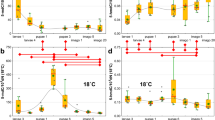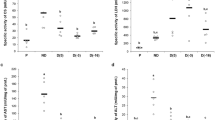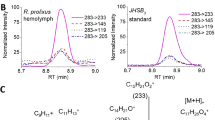Abstract
2-14C-Pteroyl-L-monoglutamic acid (0.5 mc. per millimole, 1 mgm.) was incorporated into banana food medium (100 gm.), and adult flies of Drosophila melanogaster (Oregon, wild-type) were allowed to feed and lay eggs on this medium. Larvæ (six days old) were removed from this medium, transferred to moist filter paper and allowed to pupate. Pupæ (100; 86 mgm.; not less than 48 hr., not more than 56 hr. pupation) were crushed with sand and 0.5 N aqueous ammonia solution (0.5 ml.) and heated on a steambath (10 min.). Solids were centrifuged off and supernatant liquid spotted on Whatman 3 MM paper. The solids were washed again with 0.5 N aqueous ammonia solution (0.4 ml.), centrifuged off and supernatant liquid added to the first spot. The paper area was cut out and radioactivity measured by immersion in a solution of 0.3 per cent diphenyloxazole in toluene (2 ml.) and counting with a ‘Panax’ scintillation counter (background, 1.096 counts/sec; background + sample, 1.357 counts/sec; sample, 0.26 count/sec; standard error, ± 0.035 count/sec). The radioactive area of the paper was chromatographed on 3 MM paper with propanol/5 per cent aqueous acetic acid (2 : 1 vol. by vol.) as developing solvent. To improve spot resolution, the paper was developed three times. On viewing in 365-mµ light, a bright purple fluorescent area was seen. This was cut out and chromatographed on 3 MM paper with butanol/acetic acid/water (4 : 1 : 5 vol. by vol.) (triple development). After air-drying, the paper was viewed in 365 mµ light and the fluorescent spots of isoxanthopterin (purple) and 2-amino-4-hydroxy-pteridine-6-carboxylic acid (bright blue) cut out. The acid spot was measured for radioactivity (background, 0.65 count/sec; background + sample, 1.10 counts/ sec; sample, 0.45 count/sec; standard error, 0.033 count/sec). The isoxanthopterin spot was further purified by chromatography on 3 MM paper with tert.-butanol/pyridine/water (50 : 15 : 35 vol. by vol.). The isoxanthopterin spot was measured for radioactivity (background, 0.65 count/sec; background + sample, 0.76 count/sec; sample, 0.11 count/sec.: standard error, 0.030 count/sec).
This is a preview of subscription content, access via your institution
Access options
Subscribe to this journal
Receive 51 print issues and online access
$199.00 per year
only $3.90 per issue
Buy this article
- Purchase on Springer Link
- Instant access to full article PDF
Prices may be subject to local taxes which are calculated during checkout
Similar content being viewed by others
References
Blair, J. A., and Graham, J., Chem. and Indust, 1158 (1955). Blair, J. A., Biochem. J., 65, 385 (1958).
Oshima, C. Seki, I., and Ishizaki, H., Genetics, 41, 4 (1956).
Hubby, J. L., and Forrest, H. S., Genetics, 45, 211 (1960).
Sang, J. H., J. Exp. Biol., 33, 45 (1956).
Green, D. E., Westerfeld, W. W., Vennesland, B., and Knox, W. E., J. Biol. Chem., 145, 69 (1942). Berg, R. L., and Westerfeld, W. W., ibid., 152, 113 (1944). Neuberg, C., and Rosenthal, O., Ber. deut. chem. Gesell., 57, 1436 (1924). Holzer, H., and Beauchamp, K., Angew. Chem., 71, 776 (1959).
Discherl, W., Z. physiol. Chem., 219, 177 (1933).
Neuberg, C., and Ohle, H., Biochem. Z., 128, 610 (1922).
Author information
Authors and Affiliations
Rights and permissions
About this article
Cite this article
BLAIR, J. Conversion of 2-14C-Pteroyl-L-Monoglutamic Acid into Isoxanthopterin in Drosophila melanogaster. Nature 192, 757–758 (1961). https://doi.org/10.1038/192757a0
Issue Date:
DOI: https://doi.org/10.1038/192757a0
This article is cited by
-
Pterine als Wirkstoffe und Pigmente
Ergebnisse der Physiologie Biologischen Chemie und Experimentellen Pharmakologie (1965)
Comments
By submitting a comment you agree to abide by our Terms and Community Guidelines. If you find something abusive or that does not comply with our terms or guidelines please flag it as inappropriate.



